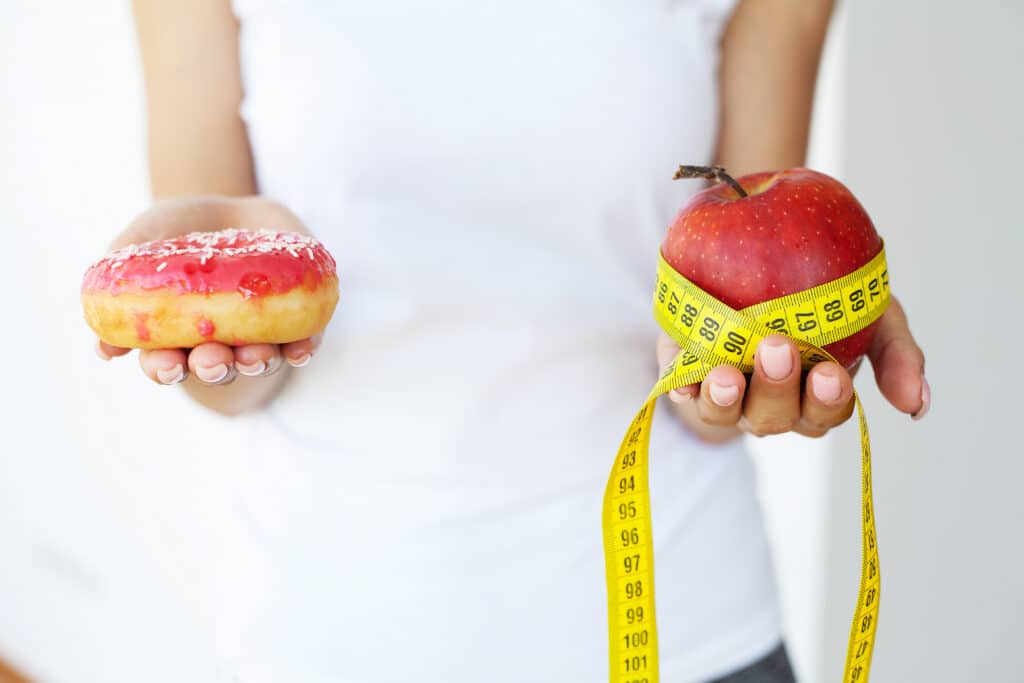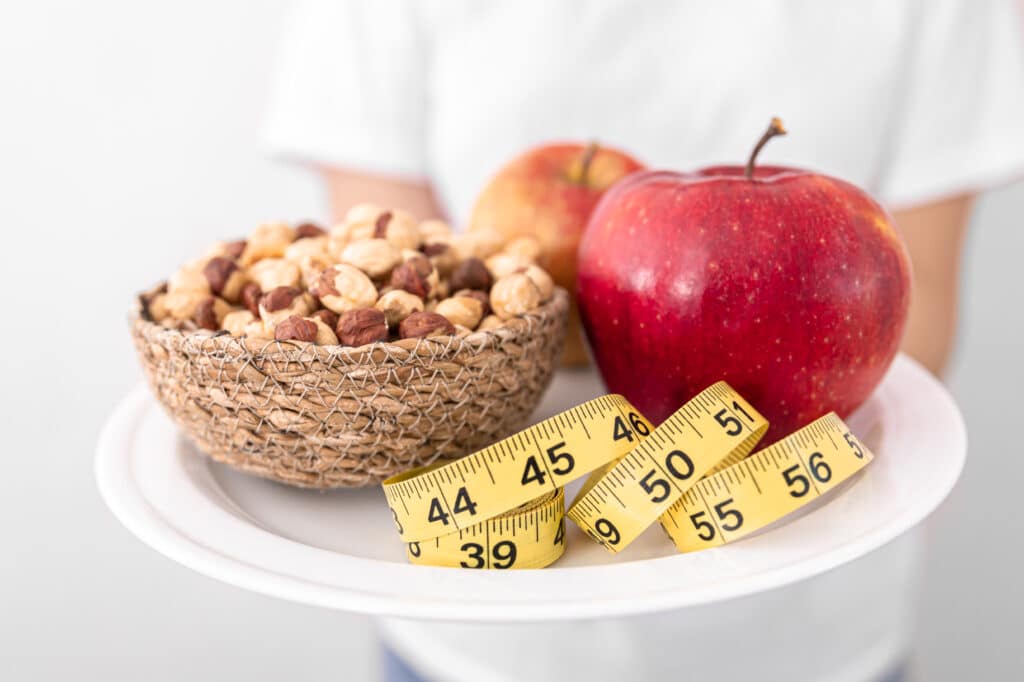Become your healthiest self, physically and mentally, with Trainer and Nutrition Coach, Becca Gillen, advocate for flexible dieting. Becca believes you should be able to eat chocolate and pizza while still maintaining a healthy lifestyle. Here, she explains how:
“All you need is to understand WHY ‘unhealthy’ foods like pizza won’t make you fat, how to understand a calorie deficit and the very basics of fat loss. I want to squash your fear of eating ‘fun’ foods and teach you how to manage your social life. Slice up!”
The best things come in moderation – and the best diet is no exception!

Five tips to understanding flexible dieting and how to educate yourself and your clients
Tip #1 – Change your mindset about dieting
I want to make this very clear from the start – there are no ‘good’ or ‘bad’ foods.
Eating salads doesn’t magically make you thin. Pizza doesn’t have magic spells to make you fat. It’s the calories within the foods that will lead to your fat melting off you.
The problem comes from people labelling foods as ‘junk’ and ‘healthy’. For example, we all know that a quinoa salmon salad will be more nutritious than pizza. However, a lot of ‘healthy’ foods contain high fats (good fats, but still high).
So, even though you’re eating ‘healthy’, you may still struggle with weight loss. The reason for this is that you’re just not in a calorie deficit. Eat all the avocados you want, but if you want to drop weight, you need to find your calorie deficit.
Moderation is the name of the game here. High fats are high fats, no different if they are classed as “healthy” or “junk”. (Nutritious food is still very important, so don’t take this to mean you can just eat fries and burgers!). The healthiest diets come from understanding your needs and meeting them.
Tip #2 – Create a calorie deficit
In order to lose fat, you need to have a calorie deficit. This means you need to be burning more calories than you are consuming. If you consume too many calories and don’t move around enough, you will gain weight. Simple as that.
Even healthy foods like avocados, nuts, coconut oil or your BS ‘bulletproof coffee’ are high in calories and can send you into a calorie SURPLUS, thus gaining weight.
Yes, they are healthier than a McDonald’s, but your double cheeseburger may be 1/4 of the calories of your bag of nuts, and twice as much protein!
If you consume too little and exercise a lot, you will lose weight, but you’ll also lose muscle, energy, friends, and the will to live. With flexible dieting, it’s important to find a balance and exercise routine that allows you to eat foods you love without worrying about gaining weight.
Tip #3 – Find your calorie requirements
To be in a calorie deficit, you first need to find out your calorie requirements. One tip in figuring this out (because everyone will be different) is to AVOID using MyFitnessPal. MyFitnessPal is an app. It knows nothing about you, your body composition, your training, your eating habits, or your lifestyle.
Fellow trainers – this can all be done through the My PT Hub macro calculator!
There is no one size fits all diet! The best diet for you will not be the same as other people, it is very important to work out the healthiest diet for your lifestyle, especially if your focus is losing weight!

Tip #4 – Track your calories
To find the best flexible diet for you, this is a good place to start. You can find out roughly what you may need to eat to get into a calorie deficit.
Not everyone needs to track calories to drop body fat, but it is a good way of knowing how much you’re eating and when to eat more (or pull back).
The aim of tracking calories is to figure out your baseline, and then, as you get more experienced you won’t need to track calories as rigidly. Flexible dieting will be able to help with this, and you’ll be able to eyeball portions and do less tracking.
You may need to reduce the amount of calories you eat to stay in a calorie deficit.
Flexi diet tips to help you reduce your overall calorie intake:
- Replace cooking oils with 1 cal spray.
- If you’re a sweet snacker, switch from milk chocolate to 55% cocoa first. After this, try 65%/70%, and see if you can make it to 74-85% dark chocolate over the next few months. It’s harder to over-indulge on dark chocolate because it’s much richer than milk chocolate.
- If you’re a savoury snacker – try buying smaller packets of crisps or rice cakes.
- Even better, swap crisps for plain tortillas and add lean beef mince with lean vegetables on top to make a low-calorie, high-protein meal.
- Try Greek yoghurt for a high-protein snack that will keep you fuller for longer. This way, you’ll be less inclined to reach for more snacks.
- If you’re used to more than one take away in a week, limit yourself to once at the weekend. This will significantly reduce your calorie intake across the week.
- Increase your activity levels.
- If you’re a desk worker, and your activity is low, have a look at your daily steps. In cold countries, aim for 7.5-10k steps, especially if there’s snow. In hot countries you should be aiming well above 10k, possibly even 12-15k. If you don’t have a Fitbit or an activity tracker, some smartphones will record your steps whilst you carry it with you.
Before you set your target number of steps, find out your current daily average. Aim to increase this by 1000 steps per day for the remainder of the week. Walk to the upstairs toilets in the office, walk to the shop to get that loaf of bread, and get off the bus one stop earlier. Find ways you can add those important extra steps to your day.
Tip #5 – Track your progress
Incorporate the flexible dieting tips I’ve given you and keep track of your progress. The best way to do this is by taking progress photos and accurate measurements. If you’re not sure how to take your own measurements, watch my instructional video below.
If you still look and feel the exact same after 2 weeks, then you’re likely not in a large enough calorie deficit and either need to output more or eat less.
Reflect on the previous 2 weeks and see if your weekends may have had an impact. A calorie deficit needs to be created across the 7 days. So, if you’re only doing it for 4 days and letting it slip at the weekend, then this is probably why you’re not losing weight!
My main point is that there are no ‘good’ and ‘bad’ foods when it comes to fat loss. The best diet is one that you build around you and your body’s needs. The single most important factor is that you’re creating that calorie deficit with a combination of food reduction and an increase in activity.
If your pizza fits into your calorie deficit – you can have this every week and still get lean. I chose pizza because I absolutely love it, but this could be a burrito or even chocolate!
Start flexible dieting the right way today
Thanks for reading – I’d love to know your thoughts on flexible dieting. If you want to learn more about what calories are right for you – drop me an email becca@beccagillen.com or find yourself a good coach to help you calculate your total daily energy expenditure/calorie requirements.